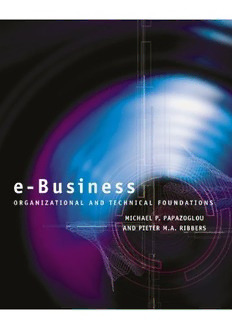
e-Business. Organizational and Technical Foundations PDF
Preview e-Business. Organizational and Technical Foundations
Contents Cover e-Business: organizational and technical foundations 2 Title Page Copyright About the Authors Foreword Preface Chapter 1: The World of e-Business 1.1 What is e-Business? 1.2 Characteristics of e-Business 1.3 Elements of an e-Business solution 1.4 e-Business roles and their challenges 1.5 e-Business requirements 1.6 Impacts of e-Business 1.7 Inhibitors of e-Business 1.8 Chapter summary Chapter 2: e-Business Strategy 2.1 What is e-Business strategy? 2.2 Strategic positioning 2.3 Levels of e-Business strategy 2.4 The changing competitive agenda: business and technology drivers 2.5 The strategic planning process 2.6 Strategic alignment 2.7 The consequences of e-Business: theoretical 3 foundations 2.8 Success factors for implementation of e-Business strategies 2.9 Chapter summary Chapter 3: Business Models 3.1 Pressures forcing business changes 3.2 Business models – definitions 3.3 Classifications of business models 3.4 Towards networked business models 3.5 Chapter summary Chapter 4: e-Business Relationships 4.1 Modeling interdependent business activities: the value chain 4.2 Business processes and their management 4.3 Types and characteristics of e-Business relationships 4.4 Electronic links and the value chain 4.5 Chapter summary Chapter 5: Governance Structures 5.1 Markets vs. hierarchies: theoretical contributions 5.2 Networks 5.3 A supply chain perspective: value-adding partnerships 5.4 The effects of information technology on governance 5.5 Chapter summary Chapter 6: e-Business Technological Infrastructure 4 6.1 Technical e-Business challenges 6.2 Basic infrastructure: client/server technology 6.3 Web technologies and applications 6.4 Collaborative technologies 6.5 The role of enterprise information systems in e- Business 6.6 Chapter summary Chapter 7: XML the Enabling Technology for e-Business 7.1 Brief overview of XML 7.2 Characteristics of XML documents 7.3 Defining structure in XML documents 7.4 Document presentation and transformation 7.5 Processing XML documents 7.6 XML, EDI and e-Business 7.7 Chapter summary Chapter 8: e-Markets 8.1 Electronic markets defined 8.2 The functions of electronic markets 8.3 How do electronic markets differ from traditional markets? 8.4 What are the effects of electronic markets? 8.5 Electronic market success factors 8.6 e-Market technology solutions 8.7 Chapter summary Chapter 9: e-Procurement 9.1 Introduction 5 9.2 The purchasing process 9.3 Developments in purchasing 9.4 IT and purchasing 9.5 e-Procurement 9.6 Auctions 9.7 e-Procurement solutions 9.8 Chapter summary Chapter 10: e-Business Networks 10.1 Introduction 10.2 Network organizations 10.3 Interorganizational information systems and network organizations 10.4 Supply chains 10.5 Integrated supply chains 10.6 Concluding remarks 10.7 Chapter summary Chapter 11: Intermediaries in the Value Systems 11.1 Introduction 11.2 Definition and classification of intermediaries 11.3 Dynamics in the value system 11.4 Chapter summary Chapter 12: e-Business Modeling 12.1 Business modeling 12.2 Business processes and collaborations 12.3 Business modeling with UML 12.4 Business process modeling methodologies 6 12.5 The Supply-Chain Operations Reference (SCOR) model 12.6 Business process modeling notation 12.7 Comparing BPMN with UML 12.8 The Model Driven Architecture (MDA) 12.9 Chapter summary Chapter 13: Security and Reliability for e-Business 13.1 Reliability and quality considerations 13.2 Quality requirements 13.3 Trust 13.4 e-Business risks 13.5 e-Business security 13.6 Realizing a secure e-Business infrastructure 13.7 Chapter summary Chapter 14: Approaches to Middleware 14.1 What is middleware? 14.2 Messaging 14.3 Remote Procedure Calls (RPCs) 14.4 Remote Method Invocation (RMI) 14.5 Message-Oriented Middleware (MOM) 14.6 Data-access middleware 14.7 Transaction-oriented middleware 14.8 Distributed-object middleware 14.9 Newer generation frameworks 14.10 Chapter summary Chapter 15: Component-based Development 7 15.1 What are components? 15.2 Interfaces and contracts 15.3 Business components and entities 15.4 Component models and compositions 15.5 Component frameworks and patterns 15.6 Business 15.7 Business component-based design and development 15.8 Advantages and limitations of component-based development 15.9 Chapter summary Chapter 16: Leveraging Legacy Applications 16.1 Enterprise information systems and legacy enterprise assets 16.2 Strategies for modernizing legacy systems 16.3 Non-invasive approaches 16.4 Invasive approaches 16.5 Legacy modernization techniques 16.6 Chapter summary Chapter 17: Enterprise Application Integration 17.1 The application integration imperative 17.2 Operational and financial drivers 17.3 What is Enterprise Application Integration? 17.4 Typical topologies for enterprise application integration 17.5 Types of application integration: passive vs. active 17.6 Layers of EAI integration 17.7 Workflow, EAI, and BPM technologies: A 8 comparison 17.8 When to use synchronous or asynchronous communication 17.9 Elements of the application integration architecture 17.10 Implementing business process-level EAI 17.11 Summary of application integration infrastructure functions 17.12 Chapter summary Chapter 18: e-Business Integration 18.1 Business processes and e-Business integration 18.2 Business process redesign 18.3 e-Processes 18.4 Overview of e-Business integration 18.5 Topologies for e-Business integration 18.6 Workflow, BPM, EAI and e-Business 18.7 Integration challenges: the semantic interoperability problem 18.8 Business integration patterns and their implications 18.9 e-Business integration requirements revisited 18.10 Wrapping up: the real differences between e- Business and EAI 18.11 Chapter summary Chapter 19: Loosely Coupled e-Business Solutions 19.1 Introduction 19.2 The concept of software as a service 19.3 What Web services are 19.4 Web services: types and characteristics 9 19.5 The service-oriented architecture 19.6 The web services technology stack 19.7 Web services standards 19.8 Web services orchestration 19.9 Web services transactions 19.10 Web services security and policy considerations 19.11 EAI and Web services 19.12 Chapter summary Note Chapter 20: Business Protocols 20.1 Introduction 20.2 Why are business standards and protocols needed? 20.3 XML technology stack for e-Business integration 20.4 RosettaNet 20.5 Electronic business XML 20.6 Convergence between Rosetta, ebXML and Web services 20.7 Chapter summary Note Glossary Reference Index e-Business: organizational and technical foundations “At last, a book that explains e-Business from all angles. Readers will enjoy a 10
